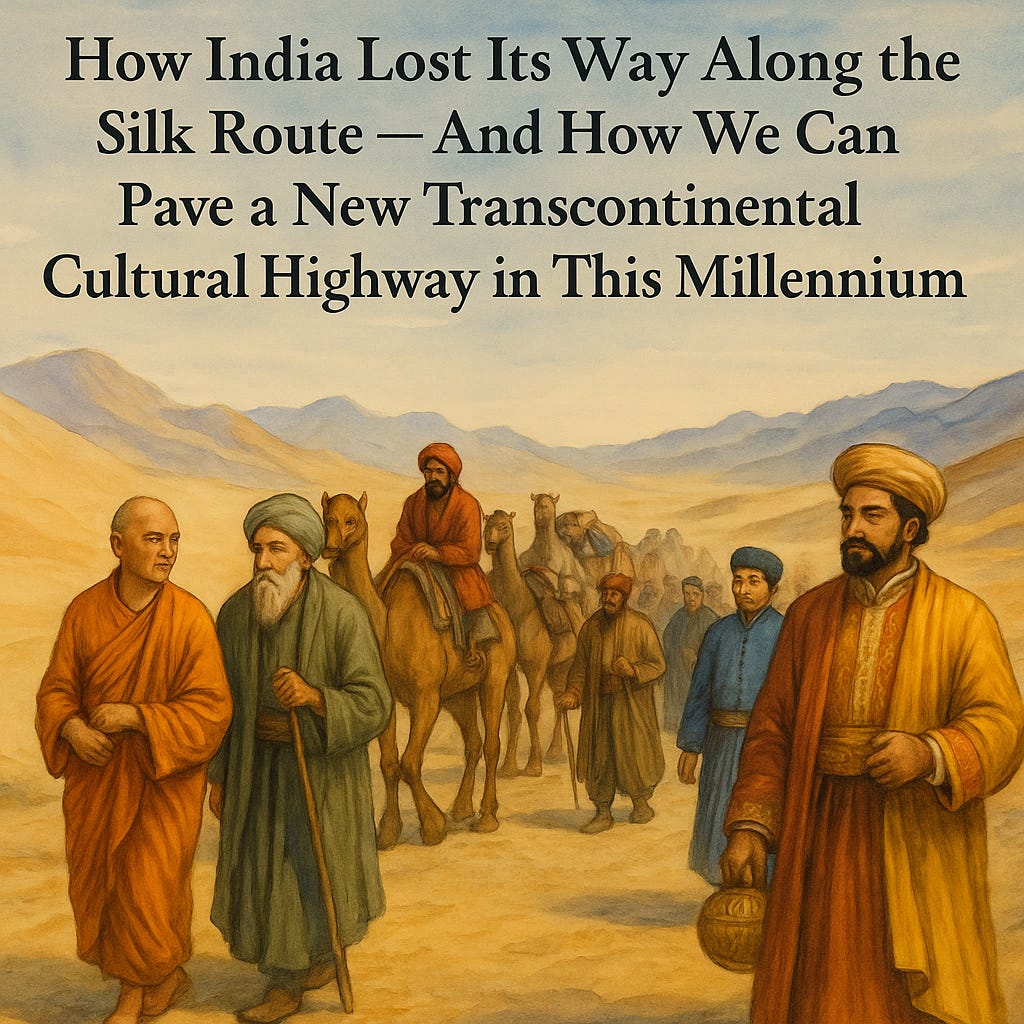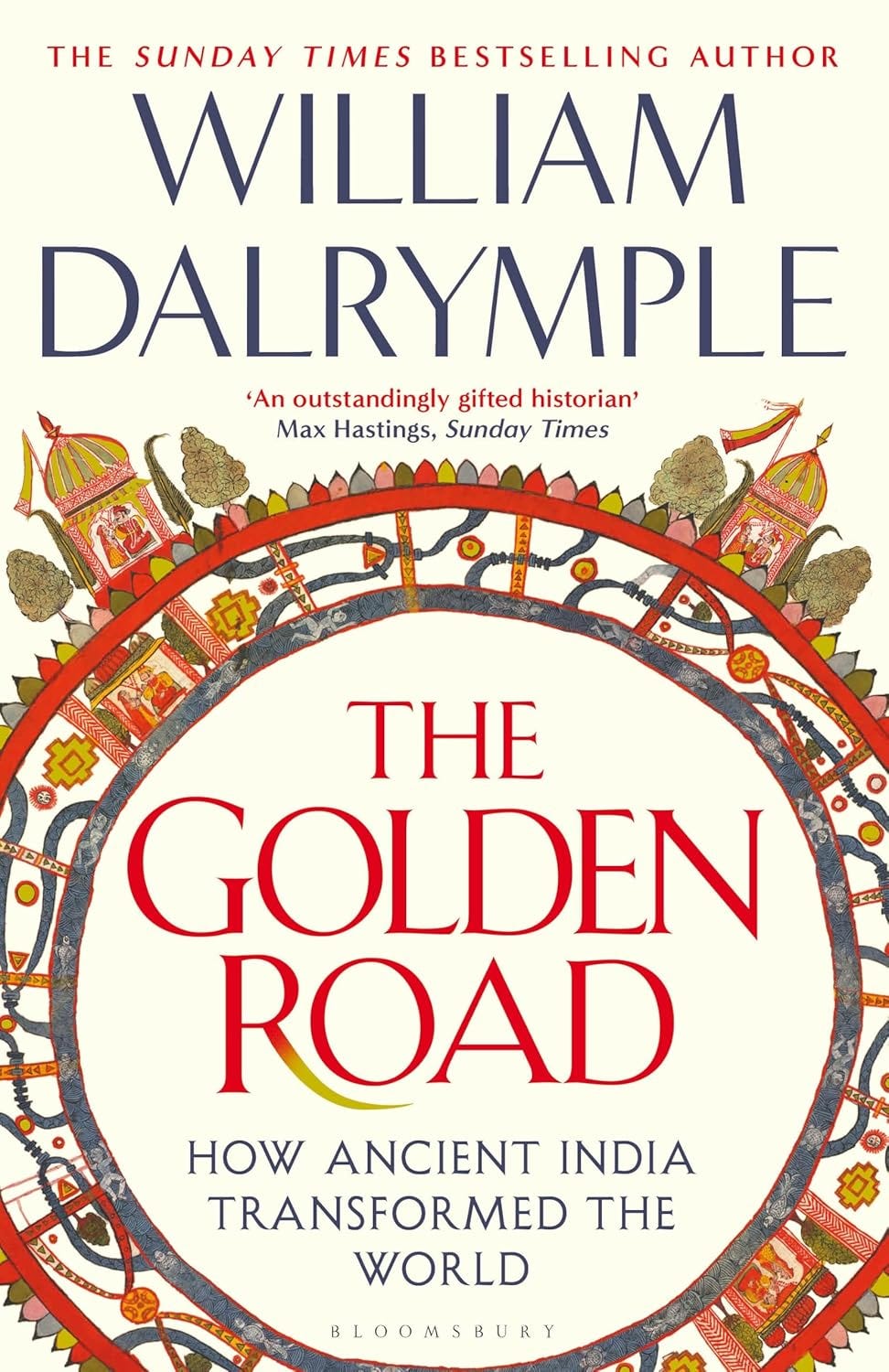How India Lost Its Way Along the Silk Route — and how we can Pave a New Transcontinental Cultural Highway in this Millennium
Let The Golden Road not remain a British historian’s monument to our past, but a catalyst for us—the people, the state, and the scholars—to rebuild a new superhighway of influence for the modern age.
About the Author
Karan Bir Singh Sidhu is a retired IAS officer of the Punjab cadre, with a long-standing interest in Indian history, comparative religion, and public policy. He writes frequently on civilisational themes, cultural revival, Sikh theology, and strategic affairs.
How India Lost its Way Along the Silk Route it helped Build
The term “Silk Road” typically conjures vivid images of camel caravans hauling Chinese silks across the deserts of Central Asia to bustling Middle Eastern markets and Roman ports. China proudly invokes this imagery to give historical gravitas to its present-day Belt and Road Initiative. But as acclaimed historian William Dalrymple powerfully argues in his latest book, The Golden Road: How Ancient India Transformed the World, it was India, not China, that lay at the cultural and commercial crossroads of the ancient world. Long before the term “Silk Road” entered our imagination, Indian merchants, monks and mariners were already building maritime routes, trading luxury goods, and spreading ideas across the Eastern Hemisphere.
This article draws inspiration from Ishaan Tharoor’s engaging interview with Dalrymple in The Washington Post (Ishaan, notably, is the son of Dr Shashi Tharoor). But it seeks not just to paraphrase that conversation—it poses a more urgent and introspective question: How did India let this soft-power empire slip into obscurity, and what must we do to reclaim and reimagine it for our times?
Who is William Dalrymple?
William Dalrymple, a Scottish-born writer and historian, has long been one of the most prolific chroniclers of the Indian subcontinent. His bibliography spans travelogues (In Xanadu), historical epics (The Last Mughal, Return of a King), and grand economic histories (The Anarchy). Dalrymple has lived in India for decades and has become a familiar voice on its past. Though some critics question whether a British writer should occupy such a prominent space in narrating India’s history, his scholarship remains influential and widely respected.
In The Golden Road, Dalrymple challenges the China-centric narrative of the Silk Road and redirects our gaze to the Indian Ocean world—where India’s intellectual, spiritual and material exports reached deep into Central Asia, East Africa and South-East Asia. From Sanskrit texts to Chola bronzes, India’s soft power was immense—radiating influence through attraction rather than conquest.
India’s Reach Without an Empire
Unlike Rome or imperial China, early India rarely enjoyed a single, centralised authority pushing outward. Yet Dalrymple describes an “Indosphere” whose cultural breadth was immense. Hindu traditions spread widely in South-East Asia, while Buddhism ranged much further – through the Central Asian ‘Stans, Afghanistan, western China, Mongolia, Korea, Japan and the islands of South-East Asia. Because Buddhists are now few in India, the country seldom celebrates this extraordinary exercise in soft power: Buddhism travelled entirely by persuasion, not conquest. Monasteries doubled as banks, factories and caravanserais, making the faith attractive to merchants.
From roughly 600 CE to 1200 CE the prestige of Sanskrit produced what scholar Sheldon Pollock calls the “Sanskrit Cosmopolis”. Across a zone stretching from Kandahar to Bali and on to Japan, Sanskrit (and its liturgical companion Pali) served as the language of courts, diplomacy and scholarship – a sphere larger, richer and more sophisticated than Rome at its height, and flourishing while Europe languished in the early Middle Ages.
The Forgotten Empire of the Mind
India’s global footprint was not carved out by legions or annexations, but by pilgrims, scholars and traders. Buddhist missionaries reached as far as Japan and Siberia. Indian epics were etched into the walls of Angkor Wat and Borobudur. Monasteries not only disseminated religious teachings but also acted as hubs of economic activity—offering banking, shelter and learning.
The Roman chronicler Pliny the Elder lamented that India was draining the empire of gold and silver. Indeed, Roman tariffs on Indian goods such as pepper, silk and cotton—sourced in Kerala and Gujarat—may have contributed up to a quarter of the imperial budget. This wasn’t mere trade; it was civilisational exchange.
Where Did We Lose the Plot?
India’s civilisational legacy, once radiant across continents, was gradually eclipsed under colonial rule. British administrators, most notably Macaulay, dismissed Indian learning with imperial arrogance—infamously claiming that a single shelf of European books was worth more than all the literature of India and Arabia. In reaction, some nationalist historians of the early twentieth century swung too far in the opposite direction, framing India’s ancient outreach as a tale of “Hindu colonies” in South-East Asia—a narrative swiftly and rightly rejected by postcolonial scholars in those regions, who sought to assert indigenous agency and rejected terms like “Indianisation” altogether. In the process, the subtler reality of civilisational exchange was lost—reduced either to nationalist myth-making or buried beneath academic hesitation.
Even within India, robust research has too often remained confined to isolated academic silos—rich in insight but poorly integrated and rarely accessible to global or even national audiences.
Dissemination or Cross-pollination?
Dalrymple offers a more nuanced metaphor. He likens Indian influence to seeds that took root in new soils, evolving into distinct cultural forms. Rabindranath Tagore grasped this insight during his 1920 visit to Angkor. Standing amid the ruins, he remarked: “Everywhere I seem to see India. Yet I can no longer recognise it.”
That sentiment captures a profound truth: India’s genius lay not in cloning itself abroad, but in inspiring others to interpret its ideas in their own idiom.
And yet, today, it is striking—and sobering—that a British author must remind the world of India’s once-central role in shaping civilisation. Is this simply a matter of global publishing power? Or does it reflect a deeper malaise—a civilisational self-doubt still seeking approval from London or Washington? Have Indian scholars, constrained by ideological silos—be they Marxist, Hindutva-driven or linguistically partisan—missed the opportunity to offer the world a balanced, inclusive and compelling retelling of India’s universal legacy?
What Can We, the People and the State, Do?
1. Champion rigorous, non-sectarian scholarship
Fund multi-disciplinary centres that pair archaeology with textual studies and the hard sciences (DNA, climate, materials analysis).
Incentivise peer-reviewed translations of Sanskrit, Prakrit, Pali, Tamil and classical Chinese sources into accessible English and Indian languages—avoiding both nationalist bombast and self-loathing minimalism.
2. Reform public history
Refresh school and university curricula so they reflect the cosmopolitan Indosphere rather than a narrow Delhi-centred dynastic timeline.
Equip museums with interactive digital reconstructions—virtual voyages down the monsoon routes; 3-D scans of South-East-Asian reliefs alongside their Indian prototypes.
3. Foster citizen engagement
Encourage community archaeology and crowdsourced heritage mapping apps, letting ordinary Indians tag inscriptions, trade-guild emblems and votive stupas in their districts.
Support documentary film, podcast and graphic-novel projects that tell these stories in contemporary idioms.
4. Deploy cultural diplomacy
Revive Nalanda-style scholarship exchanges: fund fellowships for Asian, African and Mediterranean researchers to study Sanskrit in India—and for Indians to examine Indian-influenced sites abroad.
Integrate the “Golden Road” narrative into India’s G-20, BRICS, SCO and ASEAN outreach, not as triumphalism but as shared heritage.
5. Enable the creative economy
Offer start-up grants to artisans who re-imagine ancient bronzework, stone-carving and textile motifs for twenty-first-century markets—turning heritage into sustainable livelihoods.
By embracing rigorous scholarship, inclusive storytelling and forward-looking cultural policy, India can reclaim an inheritance that once financed empires and fired imaginations from the Hindu Kush to the Pacific. The task is not to resurrect a lost golden age in amber but to weave that plural, outward-looking spirit into the fabric of modern citizenship—so that the next authoritative book on India’s global influence is celebrated not merely because it is well written, but because it forms just one voice among many in a confident, polyphonic chorus.
A Note of Caution for Narrow Nationalism
The RSS’s rediscovery of India’s ancient civilisational legacy could play a constructive role—if handled with pluralist vision and inclusivity. But if reduced to the narrow confines of a Hindutva worldview, or to a narrative that projects only Aryans as the civilised torchbearers of ancient India, it will risk distorting rather than celebrating the past. India’s soft power extended not just from Varanasi and Ujjain but also from Kanchipuram, Madurai, Thanjavur and Chidambaram. The Cholas’ Tamil influence in South-East Asia stands as an enduring reminder that Hinduism is not synonymous with Hindi.
Sanskrit may be revered as a classical mother of all India languages, but Tamil, Kannada, Telugu, Malayalam and other Dravidian languages played decisive roles in shaping the Indian cosmopolis abroad. To reclaim our golden legacy, we must embrace India in its totality—not as a unitary Aryan monoculture, but as a multi-ethnic, multi-lingual, plural civilisation whose genius was its openness, not its orthodoxy.
Looking Forward: Time to Rebuild the Highway
India once crafted a civilisational highway that connected Alexandria to Kyoto—not by conquest, but through compassion, curiosity and cultural brilliance. That legacy has faded not due to lack of greatness, but from historical amnesia and internal discord.
We have the resources, scholarship, technology and global stature to revive it—but only if we choose to do so collectively, wisely, and inclusively. Let The Golden Road not remain a British historian’s monument to our past, but a catalyst for us—the people, the state, the storytellers and the scholars—to rebuild a new superhighway of influence for the modern age.
Let it be India’s road once more.





